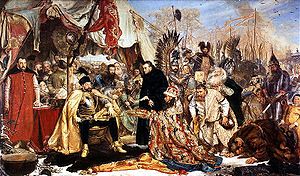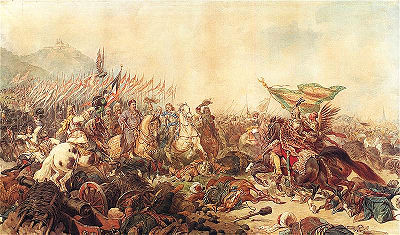
Hetman's sign
Encyclopedia

Polish-Lithuanian Commonwealth
The Polish–Lithuanian Commonwealth was a dualistic state of Poland and Lithuania ruled by a common monarch. It was the largest and one of the most populous countries of 16th- and 17th‑century Europe with some and a multi-ethnic population of 11 million at its peak in the early 17th century...
. It was invented by hetman
Hetman
Hetman was the title of the second-highest military commander in 15th- to 18th-century Poland and the Grand Duchy of Lithuania, which together, from 1569 to 1795, comprised the Polish-Lithuanian Commonwealth, or Rzeczpospolita....
Jan Tarnowski
Jan Tarnowski
Jan Amor Tarnowski was a Polish szlachcic . He was Grand Crown Hetman from 1527 and was the founder of the city of Tarnopol, where he built the Ternopil Castle and the Ternopil Lake....
, who also popularized it on the territory of Poland
Poland
Poland , officially the Republic of Poland , is a country in Central Europe bordered by Germany to the west; the Czech Republic and Slovakia to the south; Ukraine, Belarus and Lithuania to the east; and the Baltic Sea and Kaliningrad Oblast, a Russian exclave, to the north...
in the second half of the sixteenth century. In Lithuania
Lithuania
Lithuania , officially the Republic of Lithuania is a country in Northern Europe, the biggest of the three Baltic states. It is situated along the southeastern shore of the Baltic Sea, whereby to the west lie Sweden and Denmark...
the hetman's sign was accepted in the following century. It became the most popular under reign of king Jan III Sobieski. Although he received the crown, he didn't reject his former attribute of authority. However from the mid of the eighteenth century hetman's sign was replaced by horse-tail ensign.

This symbol was attributed only to a hetman. When a hetman was riding a horse, hetman's sign was carried by a horseman behind him. This sign was to emphasize the dominating role of hetman
Hetman
Hetman was the title of the second-highest military commander in 15th- to 18th-century Poland and the Grand Duchy of Lithuania, which together, from 1569 to 1795, comprised the Polish-Lithuanian Commonwealth, or Rzeczpospolita....
as a commander-in-chief of an army and to manifest the features of an ideal hetman. It fulfilled the important utilitarian role at a battle field. It informed the soldiers, where the hetman was, and assured them of his constant presence at the battle field.

